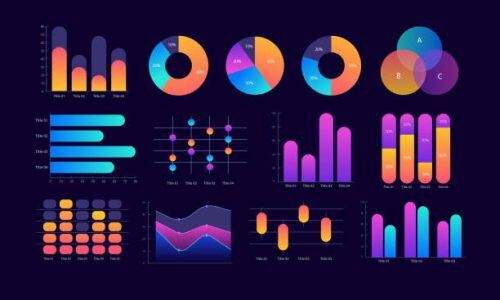You can have the perfect questionnaire. Expertly crafted questions, validated scales, flawless survey logic. None of it matters if
This article delves into the critical metrics that are instrumental in shaping data-driven strategies. We will explore essential KPIs such as brand awareness, customer satisfaction, net promoter score, and consumer loyalty. Each of these metrics offers unique insights into the health and position of a brand in the competitive market landscape. Additionally, we will discuss the importance of segmenting data to unearth deeper insights and tailor strategies to specific audience segments. With practical tips on data interpretation and visualisation, we aim to equip marketers and business leaders with the tools necessary to leverage these metrics effectively, ensuring that every decision is backed by robust data and contributes to sustained business growth.

UNDERSTANDING KEY METRICS
Key performance indicators (KPIs) are crucial for assessing the effectiveness of various business strategies and operations. Understanding how to measure and interpret these metrics can significantly enhance decision-making processes.
Brand Awareness: Importance and Methods of Measurement
Brand awareness reflects how familiar your target audience is with your brand and its products or services. High brand awareness is often associated with increased consumer trust and a larger market share. Measuring brand awareness can be done through various methods such as surveys that ask consumers if they recognise your brand, tracking search volume for brand-related keywords, or analysing social media mentions and engagement. Tools like media monitoring services can also provide insights into how widely your brand is being discussed across different channels.
Customer Satisfaction: How to Measure and Interpret Customer Satisfaction Scores
Customer satisfaction measures how products or services meet or surpass customer expectations. It is typically gauged through customer satisfaction surveys that include questions rated on a Likert scale (e.g., 1-5, where 1 is ‘very unsatisfied’ and 5 is ‘very satisfied’). Analysing the results involves looking at the distribution of scores and reading through any accompanying qualitative feedback to understand the reasons behind the ratings. High satisfaction levels are generally indicative of customer loyalty and can predict continued business patronage.
Net Promoter Score (NPS): Explanation and Significance in Gauging Customer Loyalty
The Net Promoter Score is a metric used to gauge the loyalty of a firm’s customer relationships. It is derived from asking customers how likely they are to recommend a company’s products or services to others on a scale of 0-10. Those who respond with a score of 9 or 10 are considered ‘Promoters’; scores of 7 and 8 are ‘Passives’; and scores from 0 to 6 are ‘Detractors’. NPS is calculated by subtracting the percentage of Detractors from the percentage of Promoters. This score provides a clear indication of your company’s performance through your customers’ eyes and is a strong predictor of future growth.
Consumer Loyalty: Metrics to Assess Long-Term Customer Engagement and Retention
Consumer loyalty can be measured through repeat purchase rates, customer lifetime value (CLV), and membership or subscription renewals. These metrics provide insights into how valuable and engaged customers are over time. Tracking these over different intervals can help identify trends and determine the effectiveness of loyalty programs and customer retention strategies.
By effectively measuring and interpreting these key metrics, businesses can gain a comprehensive view of their performance and customer perceptions, which is crucial for maintaining competitive advantage and fostering long-term success.

SEGMENTING DATA FOR DEEPER INSIGHTS
Data segmentation is a powerful analytical technique that divides a broad customer base into smaller, more manageable groups based on specific criteria such as demographics, buying behaviors, or psychographics. This approach allows businesses to tailor marketing strategies and products to meet the distinct needs and preferences of each group, enhancing customer engagement and satisfaction.
Importance of Data Segmentation in Analytics
Segmenting data enhances the granularity and specificity of insights obtained from analytics. It enables businesses to identify niche markets, uncover underlying patterns, and respond more precisely to consumer trends. By focusing on segmented groups, companies can optimise resource allocation, personalise customer interactions, and ultimately achieve higher conversion rates. Additionally, segmentation helps in testing new markets or products efficiently by targeting the most relevant audiences.
Tips on How to Segment Data Effectively
- Define Clear Objectives: Start by determining what you want to achieve with your segmentation. Common goals include improving customer service, personalising marketing messages, or increasing product uptake.
- Choose Relevant Criteria: Segment your data based on variables that are meaningful for your objectives. For instance, age and location might be crucial for a retail marketing campaign, while usage patterns may be more relevant for software service improvements.
- Use Robust Data Sources: Ensure that the data used for segmentation is accurate and comprehensive. This might involve integrating multiple data sources to get a complete picture of customer behaviours and preferences.
- Regularly Update Segments: Customer preferences and behaviours can change over time. Regularly revisiting and updating your segments ensures that your strategies remain relevant and effective.
Examples of Strategic Decisions Influenced by Segmented Data
- A retail company might use demographic segmentation to tailor product offerings and marketing messages to different age groups, boosting relevance and engagement.
- A financial services firm could segment customers based on their investment behaviours, offering personalised advice and product recommendations to suit varying risk appetites and financial goals.
- An e-commerce platform may analyse customer buying patterns and segment users by frequency and volume of purchases, enabling targeted promotions and loyalty rewards to high-value customers.
Through effective data segmentation, businesses can unlock a deeper understanding of their markets, leading to more informed and strategic decision-making that aligns with the unique characteristics and needs of their customer base.

PRACTICAL TIPS ON DATA INTERPRETATION
Interpreting key performance indicators (KPIs) effectively is essential for turning raw data into actionable insights. However, without a clear strategy and understanding of common pitfalls, the data can often lead to misleading conclusions.
How to Interpret Various KPIs
When interpreting KPIs, it’s important to consider both the context of the data and its alignment with business objectives. For instance:
- Brand Awareness: Look beyond surface-level metrics like reach and impressions to deeper engagement metrics such as shares and comments to truly gauge awareness and interest.
- Customer Satisfaction: Combine quantitative satisfaction scores with qualitative feedback to understand the reasons behind customer sentiments. This helps identify specific areas for improvement.
- Net Promoter Score (NPS): While a high NPS indicates strong customer loyalty, it’s crucial to also consider the feedback from detractors and passives to address potential issues.
- Consumer Loyalty: Assess both repeat purchase rates and the reasons for customer loyalty. Understanding why customers return, or why they don’t, can inform more targeted retention strategies.
Common Pitfalls in Data Interpretation and How to Avoid Them
- Over-reliance on Single Metrics: Depending solely on one KPI can give a skewed view of performance. Always correlate findings with other relevant metrics to get a fuller picture.
- Ignoring External Factors: Economic shifts, market changes, and competitor actions can all influence KPIs. Consider these external factors when evaluating data to avoid incorrect conclusions.
- Data Overload: Collecting too much data without a clear focus can lead to analysis paralysis. Prioritise data that directly impacts key business outcomes.
Effective data interpretation is not just about understanding what the numbers say but also why they say it and what actionable steps can be taken as a result. By approaching KPIs with a comprehensive and critical mindset, businesses can ensure that their strategies are informed by solid, well-rounded insights.

DATA VISUALISATION TECHNIQUES
Data visualisation is a critical step in the analytics process, transforming complex datasets into clear, understandable visuals that can inform strategic decisions. Effective visualisation helps stakeholders grasp difficult concepts and identify new patterns quickly.
Overview of Effective Visualisation Tools and Software
While specific brands are numerous, the key to effective data visualisation lies in choosing tools that offer flexibility, scalability, and compatibility with existing data systems. Good visualisation software should allow users to create a variety of charts, graphs, and maps, and provide functionalities for real-time data updating. These tools should support data from different sources, enabling comprehensive visual reports that combine various types of data, including real-time streams, historical data, and predictive analytics outputs.
Best Practices for Visualising Data to Inform Decision-Making
- Select the Right Type of Visual: Match the visual type to the data you’re presenting. Use bar charts for comparisons, line graphs for trends over time, pie charts for proportions, and scatter plots for relationships and distributions.
- Keep It Simple: Avoid cluttering visuals with too much information. Focus on clarity and ease of understanding. Use labels and legends sparingly but clearly, and choose color schemes that do not overwhelm the data.
- Tell a Story: Arrange visuals in a sequence that tells a story. Begin with broad overviews and drill down into specifics. This narrative approach helps viewers connect the dots between different pieces of data and see the larger picture.
How Visualisation Aids in Understanding Complex Data Sets
Visualisation converts rows of data and complex calculations into formats that are easy to understand and act upon. For example, heat maps can illustrate geographic distribution patterns that might be lost in tables of sales data. Time series visualisations can highlight trends and cycles in business activities, enabling predictions about future performance based on historical data.
Effective use of data visualisation can significantly enhance the decision-making process by providing clear insights that are accessible even to those without a deep background in data analysis. Visual tools help bridge the gap between raw data and strategic action, ensuring decisions are based on comprehensive, clearly presented information.
Wrap up
In this article, we’ve explored the essential metrics and techniques that form the backbone of effective, data-driven decision-making. Key performance indicators such as brand awareness, customer satisfaction, net promoter score, and consumer loyalty provide a comprehensive view of a brand’s health and market position. Understanding how to measure, interpret, and act on these metrics is crucial for any business aiming to enhance its strategic decisions.
We’ve also discussed the importance of segmenting data to uncover deeper insights and tailor strategies to specific audience segments, enhancing the precision and effectiveness of business initiatives. Moreover, the role of data visualisation in making complex data sets understandable and actionable cannot be overstated. By employing visualisation tools that turn raw data into clear, compelling narratives, businesses can facilitate more informed discussions and better strategic outcomes.
As you move forward, I encourage you to leverage these metrics and visualisation techniques to foster a culture of data-backed decision-making within your organisation. Embracing these practices will not only support day-to-day operational decisions but also contribute to sustained business growth and competitive advantage in an increasingly data-driven world.
Let us be your guide
Discover how Brand Health can help you unlock insights to drive your brand's growth!
Related posts
$6.8 billion. That's what Australians spent over the Black Friday weekend, according to the Australian Retailers Association and Roy
In January 2023, a major Australian retailer made a decision that would cost them 18 months of strategic clarity and nearly destroy
Revenue tells you what happened. These three questions tell you what's about to happen.
.png%3Fwidth=390%26height=50%26name=Layer_1%20(1).png)





